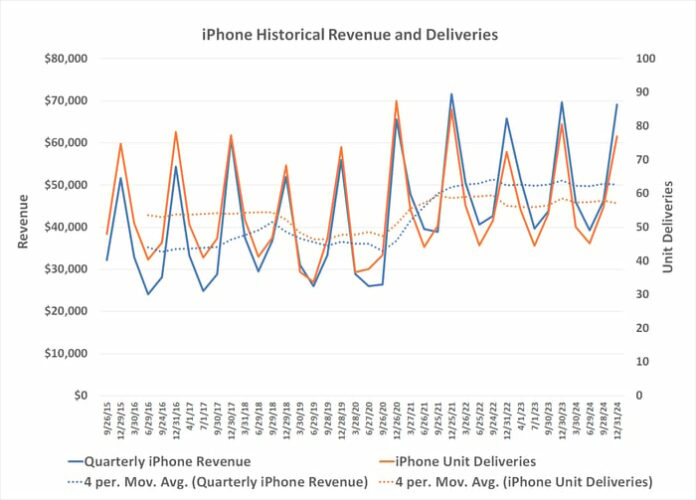Apple Enters Generative AI Market: What Investors Should Know
Generative artificial intelligence is reshaping technology in ways we are only beginning to understand. While its full impact remains to be seen, this innovation marks a significant shift reminiscent of the early days of personal computing. As a result, numerous tech companies are eager to capitalize on its potential.
Apple (NASDAQ: AAPL) is one of those companies ready to make its mark.
Start Your Mornings Smarter! Get Breakfast news in your inbox every market day. Sign Up For Free »
Like its competitors, Apple approaches the generative AI space with a unique vision and promising possibilities for investors. Here’s a closer look at their strategy.
Understanding Generative AI
So, what is generative AI? To grasp this concept, it’s helpful to differentiate it from traditional AI.
Historically, computers followed set instructions precisely as coded. These commands were straightforward, allowing machines to perform specific tasks.
Generative AI changes this by enabling computers to make responsive decisions based on user input. Whether crafting an image, summarizing complex information, or generating computer code, it adapts autonomously to requests. Some users have harnessed this technology to outline plots for stories or formulate innovative ideas.
The term “artificial intelligence” can be a bit misleading. Most AI applications depend on extensive data analysis rather than true intelligence. Nevertheless, generative AI operates similarly to the portrayals seen in science fiction, allowing users to create tailored outputs instantly. Precedence Research estimates that the global generative AI market will grow at an annual rate of 44% through 2034, reaching a value of $1 trillion.
But what exactly is Apple doing in this space?
Apple’s Generative AI Strategy
The answer is Apple Intelligence, announced in June and launched in October. Apple aims to transform its iPhones, iPads, and Macs into generative AI powerhouses. These devices will assist users in generating custom images, summarizing emails, and managing schedules. More than just software, Apple Intelligence aims to enhance the user’s overall experience.
During a quarterly earnings call, CEO Tim Cook shared, “Apple Intelligence opens up an exciting new frontier and is already elevating experiences across iPhone, iPad, and Mac. We’re going to keep investing in innovation and in transformative tools that help users in their everyday lives.”
The motivation? To increase sales of iPhones by making them essential for consumers.
Apple leads the charge in consumer-focused generative AI development. The Motley Fool noted that Apple has used the term “AI” more consistently in earnings calls than any other top player, including Nvidia and Microsoft, both formidable competitors.
However, Apple isn’t just focusing on direct on-device AI tasks. The company is also developing its own data center processor chips, which will provide additional computing power and data analysis to users needing more capability than their devices can offer.
Future Prospects
This strategy positions Apple to deliver a comprehensive generative AI solution without relying on third-party services.
Yet, it’s important to recognize that Apple hasn’t fully realized its potential just yet. In the quarter ending December, iPhone revenue was nearly flat year over year. Despite the release of the iPhone 16 in September, which supports the Apple Intelligence platform, the overall trend reflects stagnation. Although Apple no longer discloses unit sales, IDC data reveals a 4.1% year-over-year decline in iPhone shipments, even as the broader smartphone market grew by 2.4%.

Data sources: Apple Inc. and IDC. Revenue and unit data are both in millions.
While consumers have yet to fully embrace new iPhones for their AI capabilities, it may be premature to write off Apple’s efforts. Increased consumer education about generative AI could soon lead to a rebound in iPhone sales, enhancing the appeal of Apple stock.
Seize This Opportunity
Have you ever felt you missed out on investing in strong-performing stocks? This might be your chance to reconsider.
Occasionally, our expert analysts issue a “Double Down” stock recommendation for companies poised for significant growth. If you think you missed the boat, now may be the time to invest before it’s too late. Consider these historical figures:
- Nvidia: Investing $1,000 back in 2009 would yield $323,686 today!*
- Apple: A $1,000 investment in 2008 would now be worth $44,026!*
- Netflix: $1,000 invested in 2004 would have grown to $545,283!*
Currently, we’re issuing “Double Down” alerts for three exceptional companies—don’t miss your chance!
Learn more »
*Stock Advisor returns as of February 3, 2025
James Brumley has no position in any of the stocks mentioned. The Motley Fool has positions in and recommends Apple, Microsoft, and Nvidia. The Motley Fool recommends the following options: long January 2026 $395 calls on Microsoft and short January 2026 $405 calls on Microsoft. The Motley Fool has a disclosure policy.
The views and opinions expressed herein are the views and opinions of the author and do not necessarily reflect those of Nasdaq, Inc.

